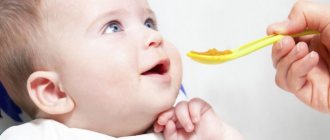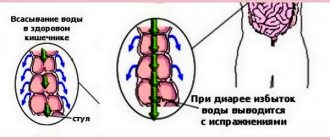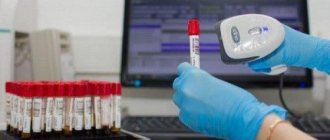When a newborn appears in the family, young parents immediately have many questions. One of the most popular and discussed topics at parenting conferences on the Internet is baby stool. New mothers are concerned about whether their baby’s bowel movements are normal, whether he has diarrhea (diarrhea) or, conversely, constipation, and whether it is necessary to take a stool test for dysbacteriosis?
Normal stool in children from 0 to one year is a relative concept. Firstly, its frequency and nature depend on the type of feeding (breastfeeding or bottle-feeding) and the availability of complementary foods. Secondly, as the child ages, the “norms” of stool change.
However, there are symptoms that are highly likely to indicate trouble in the baby’s body - if they appear, you should definitely consult a doctor :
- when breastfeeding, stool more than 7 times a day, and when feeding with formula - more than 4-5 times
- stool less than 1-2 times a day
- feces have a specific unpleasant odor or an admixture of mucus, greenery, blood
- watery or greasy stools
- When defecating, the child cries and kicks his legs
Causes of foamy stools with and without fever in children 1-6 years old
Changes in the consistency and color of stool are considered a fairly common symptom, especially in childhood. A change in diet and some other reasons provoke the disorder. Foamy stools are not typical for a child and are often accompanied by an increase in body temperature. Depending on the predisposing factor, a treatment regimen for the pathology is determined.
Infectious causes
Diarrhea in a child can be caused by infectious pathologies. Most often, the disorder acts as a complication when bacteria of various forms and types multiply in the intestines. Less commonly, the disorder is associated with the activity of certain viruses that can multiply in the digestive tract and disrupt its functioning.
In some cases, diarrhea is caused by infectious and viral diseases of the liver and intestines. Usually, with such disorders, the patient’s body temperature additionally rises, and symptoms of intoxication of the body are present.
Recognizing the infectious origin of a pathological condition is not so easy. Typically, multiple diagnostic methods are required.
Non-infectious causes
Foamy diarrhea in a 4-year-old child can be caused by non-infectious causes. Typically, with such disorders, not only diarrhea is present, but also some other manifestations.
The most common non-infectious causes of stool disorder:
- Consumption of atypical foods that were not previously included in the child’s diet. For example, when visiting a preschool institution, a temporary bowel disorder may occur due to a change in diet.
- A stressful condition that affects the functioning of the intestines and can provoke increased peristalsis.
- Chronic pathologies of the digestive tract. Some children are diagnosed with gastritis, enteritis or colitis. These pathologies are not caused by bacteria and viruses, but can lead to intestinal disorders.
- Poisoning the body with toxins and harmful substances. For children, this reason is not considered typical, but it cannot be excluded when examining the patient.
- Disturbance of the intestinal microflora as a result of the death of a large number of beneficial bacteria and the proliferation of pathogenic microorganisms.
- Abuse of products that provoke increased peristalsis. Eating fruits, vegetables, dried fruits and dairy products in excessive quantities can cause temporary diarrhea.
- Intolerance to any food components. For example, a child may have an intolerance to cow's milk proteins, as well as grains. When complementary foods in the form of cereals are introduced into a child’s diet or consumed in large quantities, celiac disease develops.
- Parasitic diseases.
These and some other reasons can provoke negative reactions from the intestines. In most cases, the symptoms disappear on their own over a certain period of time, sometimes it is necessary to prescribe medications to improve the condition.
Irritable bowel syndrome
Diarrhea with foam can occur in a child aged 3 years against the background of frequent stressful conditions, as well as with a history of chronic intestinal diseases. This disorder is usually called irritable bowel syndrome.
The disorder can occur due to the consumption of ordinary foods, as well as minor emotional disturbances. In most cases, diarrhea bothers the patient for no longer than 1 day; sometimes symptoms may persist for 2-3 days.
Drug treatment for irritable bowel syndrome does not always help to improve the condition, which is due to the origin of the disorder.
Antibiotic-associated diarrhea
When using medications with antibacterial properties, a child often develops dysbacteriosis, which provokes frequent loose stools. Adults also often suffer from such disorders, but in children they manifest themselves in an acute form and significantly worsen their general condition.
Some groups of antibiotics do not provoke stool upset, but many lead to changes in the bacterial composition, which is accompanied by stool upset. Children are less likely to take long courses of antibiotics, but use over a short period of time can also cause diarrhea. Symptoms arise as a result of the effect of antibacterial components on the intestinal microorganism. At the same time, the products destroy not only pathogenic, but also beneficial bacteria, which leads to the development of dysbacteriosis and stool disorder.
How is foamy stool formed?
Bubbles in liquid stool with foam are nothing more than gases. They are released during the life of microbes that have colonized the intestines. With normal digestion, a balance is maintained between the processes of putrefaction and fermentation in the large intestine. Putrefactive microbes - some types of bacilli, clostridia help digest protein, decomposing it into nitrogenous compounds. By-products of protein breakdown are gases - indole, skatole, hydrogen sulfide (rotten egg smell). It is these volatile compounds that give stool its characteristic “amber.”
Other microorganisms deal with complex carbohydrates - starch, inulin, fiber. Carbohydrates are fermented by lactic acid, butyric acid, and alcoholic fermentation. The main gaseous waste of the fermentation process is carbon dioxide. Typically, carbon dioxide is absorbed into the blood and excreted by the lungs. The carbon dioxide content increases sharply due to the dominance of yeast fungi in the intestines. They are responsible for alcoholic fermentation and feel very comfortable in the intestines, having plenty of simple sugars - glucose, fructose, sucrose, lactose.
If a person’s diet is based on complex carbohydrates contained in vegetables, fruits, herbs, and cereals, then lactic acid bacteria predominate, and digestion occurs as it should. When nutrition is incorrect, there is an imbalance of microflora. Colonies of microbes prevail, whose vital activity is accompanied by increased gas formation.
What symptoms accompany diarrhea with foam in various pathologies?
Foamy diarrhea in a 2-year-old child and in patients of other ages is often accompanied by other symptoms, which depend on the underlying cause of the disorder.
The most common associated abnormalities:
- Increased body temperature. Indicators in the acute stage are high and can persist for several days. Typically, antipyretic medications do not significantly improve the condition. The symptom is observed with an infectious or viral lesion of the digestive tract.
- Pain in muscles and joints occurs due to fever. The child speaks of severe weakness, his activity decreases significantly.
- Deterioration of appetite or its complete absence.
- Thirst and dryness of the mucous membranes of the mouth.
- Abdominal pain. Discomfort occurs when the disorder is of infectious or non-infectious origin, but if an infectious pathology is diagnosed, the pain is expressed in an acute form.
- Flatulence and bloating are considered common symptoms.
- Pain in the stomach area may be present when the child has a history of chronic pathologies.
- Vomiting can occur when the pathology is infectious or the body is poisoned.
- Headache and dizziness act as a concomitant symptom of intoxication during fever.
- Nausea and heartburn. These symptoms are not common, but may occur over a short period of time.
Diarrhea with foam in a child
If diarrhea develops against the background of intolerance to any foods, symptoms appear some time after eating them. It is not accompanied by an increase in body temperature, and the symptoms disappear within a short period of time.
If the disorder is of infectious origin, the symptoms gradually worsen in the absence of treatment, which only worsens the patient’s condition. Depending on the clinical picture and conditions for the occurrence of disorders, not only the treatment regimen is determined, but also the most effective diagnostic methods.
Survey
Foamy stool in a child is considered a reason to consult a doctor if it is observed several times and is accompanied by associated disorders. Diagnostics involves the use of several effective methods to obtain a complete picture of the child’s condition.
| Method | Features of the event |
| General inspection and survey | The first stage of diagnosis, which involves examining the patient and interviewing him. If the child cannot independently talk about the symptoms, parents who monitor his condition are interviewed. The doctor palpates the abdomen, examines the skin and mucous membranes, and notes possible symptoms that may indicate the development of an infectious disease. After the examination, a further diagnostic scheme is determined. |
| Clinical blood test | A standard method in which a child’s blood is examined in a laboratory to identify signs of inflammation and possible complications from internal organs. Based on the data obtained, the feasibility of prescribing certain medications is determined. |
| Coprogram | A method that involves examining stool for the presence of parasites, as well as other causes that can provoke a pathological condition. The feces are examined in the laboratory, after which the doctor determines the probable cause of the disorder. |
| Ultrasound diagnostics | An additional research method in which the organs of the digestive system are studied using a special device. As a result, it is possible to determine the presence or absence of pathologies of the liver, gall bladder, and pancreas. |
| Bacteriological culture | Culture is necessary if the disorder is of bacterial origin. Its result allows you to determine which antibacterial agents microorganisms are sensitive to. Thanks to the research, the most effective antibacterial medicine can be prescribed. |
Additionally, a blood test may be needed to determine whether the child has an intolerance to a particular product. After receiving the diagnostic results, the specialist determines the cause of the disorder and prescribes medications, if necessary.
Symptomatic therapy
Diarrhea with foam in a 1-year-old child, as well as the occurrence of symptoms in children older than this age, requires the prescription of medications to improve the condition and prevent the progression of the disease. Depending on the origin of the disorder, different remedies can be used, but the decision is made only by the doctor. It is strongly not recommended to give your child any medications without a prescription.
Dysbacteriosis
Dysbacteriosis is a pathological condition in which a change in the bacterial composition of the intestine occurs, causing stool disorder and accompanying manifestations from the internal organs.
When diagnosing diarrhea against the background of this disorder, medications are prescribed to normalize the microflora:
- Bifidumbacterin It is considered an effective remedy for the treatment of dysbiosis. It is prescribed simultaneously with other medications to achieve a pronounced effect. The drug normalizes the intestinal microflora by populating it with beneficial bacteria. Children under 1 year old take 2.5 doses 2 times a day, children over 1 year old take 5 doses 3 times a day. It is better to give the child the product in powder form, which must be diluted with water and taken orally. Treatment lasts up to 10 days.
- Espumisan is often indicated to eliminate flatulence, bloating and discomfort in the abdominal area with long-term persistence of diarrhea. It is recommended for children to take it in the form of drops. The drug is prescribed simultaneously with medications based on beneficial bacteria, which increases the effectiveness of treatment. Children under 1 year old take 25 drops of medicine 2-3 times a day. Patients over 1 year of age are advised to take 25 drops up to 4 times a day. Treatment lasts up to 7 days.
- No-spa can be used to eliminate spasms of intestinal smooth muscles. Such symptoms are often present in dysbiosis in a child. Children over 2 years old are allowed to take tablets at a dosage of 40-80 mg per day. It is imperative to divide the daily intake into 2-3 times during the day. Taking the tablets is indicated for 3-6 days.
If the patient does not have flatulence and spasms of intestinal smooth muscles, only drugs containing beneficial bacteria can be used. Depending on the symptoms, the doctor determines the dosage of the medication, taking into account the age of the child and the severity of manifestations of dysbacteriosis.
Intestinal infection
When diagnosing an intestinal infection in a child, 3 groups of medications are used to eliminate the symptoms of the disease - antibacterial agents, enterosorbents and drugs to avoid dehydration.
- Regidron refers to products that are designed to restore water balance. With an intestinal infection, loose stools are often observed, and vomiting is often present, which leads to dehydration. The powder helps restore balance and prevents the development of complications due to the loss of a large number of important components. The powder is dissolved in water at the rate of 11.95 g per 500 ml of boiled water at room temperature. Take the finished product in different dosages depending on body weight. For 1 kg of weight there is 30 ml of solution. The duration of use is 3-4 days.
- Polysorb is an adsorbent and detoxifying agent, prescribed to eliminate symptoms of intoxication and prevent the progression of disorders. The powder is dissolved in water before use. For 1 dose, a child needs 1 tsp. powder and 100 ml of water. Reception is carried out 2-3 times a day, depending on the severity of manifestations. In combination with other drugs, the drug helps to significantly improve the condition. The duration of its administration is 3-5 days.
- Antibacterial agents are always prescribed on an individual basis. There is no standard method of use, which is due to the need to select the dose and specific medicine on an individual basis. Depending on the type of infection, Kanamycin, Tetracycline, Gentamicin and other agents can be used.
Celiac disease
With celiac disease, there is an intolerance to the components of grain crops, which leads to multiple loose stools throughout the day. Some parents note that the frequency of bowel movements reaches 10 times during the day. If such disorders develop, it is worth excluding various cereals from the child’s diet.
Additionally, children may be prescribed medications to combat loose stools. For example, Smecta helps improve the condition and prevents prolonged diarrhea. Take it orally after preliminary dilution in 100 ml of 1 sachet of powder. Treatment lasts no more than 2 days.
Loperamide is prescribed to children over 2 years of age, 1 tablet 2-3 times a day, depending on the frequency of bowel movements. Treatment lasts up to 2 days. If there is no effect from the use of medications, it is necessary to place the child in a hospital and identify the cause.
Remedies from other groups are usually not used, since celiac disease most often provokes frequent loose stools.
Lactase deficiency
Foamy diarrhea in a 1-year-old child may be associated with lactase deficiency and lactose intolerance. If a specialist identifies such a deviation, it is necessary to exclude from the menu foods that provoke loose stools, for example, milk and all dairy products. This is usually enough to eliminate all symptoms.
Lactase deficiency is accompanied by bloating, so it is possible to use drugs to eliminate the symptoms. Espumisan and other simethicone-based medications are often prescribed.
Complications of pharmacotherapy
If loose stools are caused by taking antibacterial medications, the child is prescribed medications based on beneficial lactobacilli and bifidobacteria. They normalize the intestinal microflora, which allows you to get rid of diarrhea and accompanying manifestations of the disease.
In addition to Bifidumbacterin, specialists can prescribe Linex to a child in the form of drops, which is approved for use by patients from the first weeks of life. The drops are taken once a day, but the dosage depends on the age of the child. The duration of use can be up to 2-4 weeks, if necessary.
Bifiform also has pronounced properties and contains a large number of microorganisms that are beneficial for the child’s intestines. Take it 1 capsule 2-3 times a day, depending on the severity of the manifestations. The duration of the therapeutic course depends on the patient’s condition, usually 10 days is enough.
In each case, the decision to prescribe certain medications is made by the doctor based on the data of the diagnostic examination.
Use of drugs
Sometimes a child does not have accompanying symptoms of the disease, so only medications are required to eliminate diarrhea.
The most effective medications for children:
- Imodium has a pronounced antidiarrheal effect, but it is allowed to be used only in the treatment of patients over 6 years of age. Capsules are taken orally, 1 piece no more than 2 times a day. The medication helps to quickly eliminate the manifestation and prevents excessive fluid loss due to frequent loose stools. The duration of use of the medication usually does not exceed 2 days.
- Lopedium is also considered an effective remedy against diarrhea. It is prescribed in short courses of 1-3 days with daily intake of 1 to 3 tablets of the medicine. The medication is indicated for patients over 6 years of age, but in some cases the doctor may prescribe it to a child under 6 years of age based on individual indications.
If loose stools do not occur many times during the day, special medications may not be prescribed. In this case, the child’s diet is changed, some foods are excluded and the amount of liquid consumed during the day is increased. In each case, an individual approach to each child is required.
Age norms
A breastfed newborn baby can have bowel movements as many times as he is fed. If a child has stool 1-2 times a day or less during the first 3 months of life, you should consult a doctor. For bottle-fed children under one year of age, constipation is considered to be the absence of independent bowel movements during the day.
A common cause of constipation in breastfed infants is disturbances in feeding and nutrient absorption. If there is quantitative underfeeding or good absorption of the mother's breast milk, the volume of feces in the child is not sufficient to arouse the urge to defecate. In such cases, retention of stool for 2–3 days is not considered true constipation. Constipation in infants who are breastfed and complementary foods is caused by a lack of foods containing plant fiber. Excess fat in food aggravates constipation, promoting the formation of soap in the intestines and thereby further hardening the stool.
In addition to reducing the frequency of bowel movements with constipation, children may experience a decrease in appetite and abdominal pain. With chronic constipation, the volume of stool increases.
Prescribing proper nutrition
A prerequisite for treating diarrhea in a child is to change the diet and exclude from it foods that can aggravate the condition or provoke its re-development.
Experts recommend avoiding the following foods:
- Fatty meat and dairy products.
- Nuts.
- Fresh vegetables and fruits.
- Freshly squeezed juices.
- Porridge should also be excluded if an intolerance to certain components of grain products is diagnosed.
The child's diet should consist of boiled or stewed dishes. Vegetables can be steamed; apples and some other fruits are also better baked. It is allowed to eat jelly, jelly, biscuits. Depending on individual indications, certain products may be excluded.
Compliance with these nutritional rules during the period of therapy and after its completion allows you to avoid the development of complications and speed up the recovery process. After eliminating diarrhea and accompanying symptoms, it is recommended to adhere to the diet for another 1-2 weeks. The absence of symptoms during this period is considered a reason to gradually include familiar foods in the menu, unless intolerance is observed.
Diarrhea with foam can occur in a child of 1 year of age, as well as in older children. A symptom is considered a reason to consult a doctor, who will determine the cause and prescribe the most effective remedies.
Diarrhea in a baby - parental behavior tactics
12.04.2021
Diarrhea in a baby can drive parents crazy - bowel movements are disrupted, the child is worried, sleeps poorly or a lot, does not eat, cries. This may increase the temperature. When the first symptoms appear, it is necessary to understand the cause, take the first measures and follow the basic recommendations.
Causes of diarrhea
Diarrhea in infants refers to a change in stool consistency. It becomes watery, with mucus and undigested food particles, the number of bowel .
Causes of this condition:
- viral or bacterial intestinal infections;
- improper nutrition of the baby or mother if she is breastfeeding ;
- food intolerance to lactose, gluten and other elements;
- surgical pathologies;
- changing the formula or abrupt transition to artificial feeding with breastfeeding;
- taking certain medications, such as antibiotics.
Normally, diarrhea is not observed teething . If the condition occurs, most likely due to a weakened immune system , a bacterial or viral intestinal infection has occurred. The reason for this is that to facilitate teething , babies often put toys and objects in their mouths that may not be processed or washed.
Doctors call dysbacteriosis a common cause of diarrhea . Many experts refute this diagnosis.
What should mom do?
diarrhea occurs in a child of the first year of life, you should consult a doctor . Assigned groups for this symptom:
- sorbents;
- antibacterial drugs;
- medications to normalize intestinal ;
- antipyretics for high temperatures;
- antiviral agents.
Sorbents bind allergens , toxins, bacteria and their waste products, and other factors that provoke diarrhea and remove them from the child’s body. As a result, nausea , vomiting, and diarrhea .
If the cause is determined to be a bacterial intestinal infection and the causative agent is identified, antibacterial drugs may be recommended by the pediatrician . It is unacceptable to take them on your own.
For a quick recovery and elimination of imbalances in the intestinal , probiotics and prebiotics are indicated. These drugs are taken in a course and after the symptoms disappear for 10 days. When purchasing medications, you must pay attention to the storage conditions.
If diarrhea , antiviral drugs in the form of suppositories can be used.
Recommendations
A dangerous consequence of diarrhea in infants is dehydration. To prevent it, you need to give your baby water more often. If this is not possible with a cup or bottle, you can use a teaspoon or a syringe without a needle. If you have severe symptoms of dehydration, call an ambulance.
If your baby is breastfed, put him to your breast . This helps satiate the baby, replenish lost fluids and calm the baby. This is especially important in cases where it is not possible to drink with clean water.
Another recommendation concerns the child's nutrition. vegetables, dairy products, fruits and juices should be removed during diarrhea
For several days, you need to observe the baby's skin - dryness, the appearance of a rash, pallor and feces - the presence of streaks of blood , foam, mucus, color changes.
When do you need to see a doctor?
a doctor diarrhea occurs in a child under one year of age . Immediate attention is required in cases where there are streaks of blood and mucus in the stool, the baby has a high fever and is vomiting.
Self-medication of such a symptom in children of the first life is contraindicated. There is a high risk of dehydration and complications.
Signs of dehydration:
- dry skin, mucous membranes, tongue;
- retraction of the fontanel;
- dry mouth , crying without tears;
- weight loss due to decreased fluid in stool and vomit;
- decreased urination , urine becomes darker;
- capriciousness, lethargy of the child.
diarrhea in an infant requires qualified medical care - the pediatrician, together with the mother, will determine the possible cause, prescribe treatment and select the dosage of medications. During therapy, it is extremely important to give more liquid or put the baby to the breast , monitor the amount of urine , feces, and skin excreted.
Published in Gastroentorology Premium Clinic







